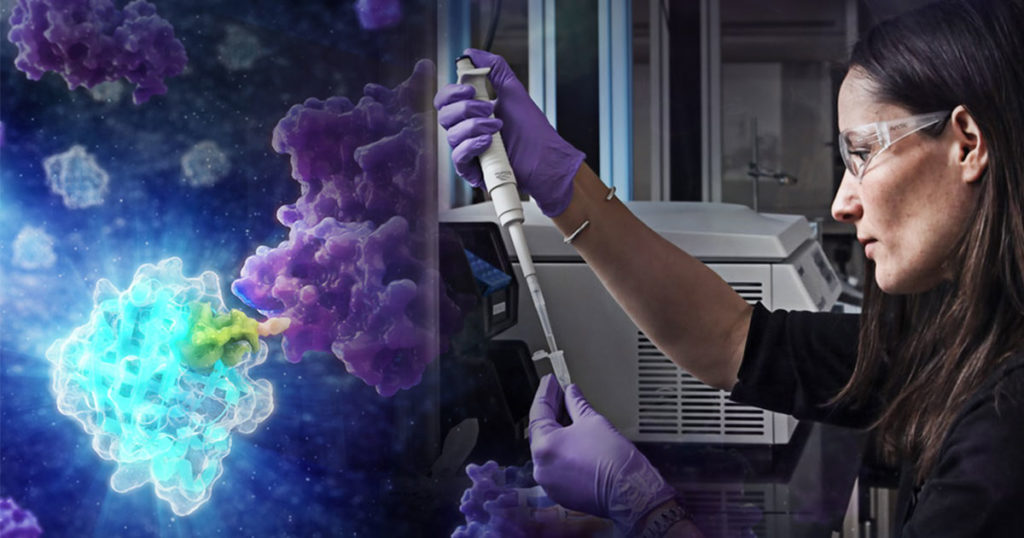Recently, selectively targeting proteins for degradation using the cell’s natural ubiquitin proteasome pathway (UPS) has surfaced as an effective strategy to bypass difficult-to-drug proteins related to diseases like cancer. Using sensitive bioluminescence technology, CRISPR-edited cell lines can facilitate studying popular protein degradation targets.

NanoLuc® Luciferase (NLuc) has made biology more accessible than ever (1). Further experimentation with NLuc led to creation of a protein complementation system (2) and the discovery of the HiBiT bioluminescent peptide. HiBiT combines spontaneously with the engineered complementary subunit LgBiT to yield an active luciferase called NanoBiT® Luciferase.
The small size and extremely bright signal of NLuc has allowed the study of events at physiological levels. Robers et al (3) demonstrated that one could monitor physiological control of stress response transcription factor stabilization with ectopically-expressed transcription factors tagged with NanoLuc® Luciferase. These critical stress response factors are continuously transcribed and translated so that the cell can respond instantly to stress.
The levels of these proteins are essentially zero in an unstressed cell. The levels are maintained by proteasomal degradation through the actions of E3 ligase-based ubiquitination. Once the cell experiences stress, the degradation signal does not occur and the concentration of stress response factor increases allowing response to the stress.
The mechanism of stress factor control is the idea behind directed targeted protein degradation, a promising method of removing a cellular protein with therapeutic implications. One of the leaders in this field, Craig Crews of Yale University (4), is using small molecules dubbed Proteolysis Targeting Chimeras or PROTACs.
A PROTAC is a bivalent molecule with one end containing an E3 Ligase binder and the other containing a target protein binder separated by a spacer. Bringing the target protein into proximity of the E3 ligase leads to ubiquitination and subsequent proteasomal degradation. Other tactics for targeted protein degradation have been demonstrated (5).
A key to much of this work was the ability to reduce the quantity of transfected NLuc fusion to extremely low levels yet still detect the signal. But how do these PROTACs truly affect the endogenous proteins? Much targeted protein degradation work relied on western blotting to follow the degradation of the target protein; however, the whole western process can be cumbersome and time consuming. CRISPR/Cas9 methods offer a solution to endogenously tag the target protein with a reporter.
NLuc is an obvious choice for CRISPR/Cas9 knock-in due to the inherent sensitivity, but HiBiT offers a more user-friendly knock-in option without cloning (6,7). Any of the five key aspects of target engagement—ternary complex formation, ubiquitination, proteasome recruitment and ultimately degradation—can be accomplished with endogenously HiBiT-tagged targets (8).
Ectopically-expressed NLuc fusions still allow detailed research into targeted protein degradation (9). Riching (10) used endogenously HiBiT-tagged targets to understand the kinetics of a PROTAC-dependent degradation of CDK2. In the data supplement of this paper, assessment of protein degradation was made comparing ectopically-expressed and endogenously HiBiT-tagged target protein. The signal is stronger with a larger dynamic range using the endogenously HiBiT-tagged target.
Lim, et al. (9) realized the advantages of using endogenously HiBiT tagged targets but state, “Although the HiBiT platform has the advantage of using a smaller tag and reports on endogenous levels of the target protein, HiBiT knock-in cell lines are time-consuming to generate.” True, going from a pool of HiBiT-positive cells to clonal cell line is time consuming; however, access to pre-built, HiBiT tagged clonal cell lines would solve the time issue.
Many endogenously HiBiT-tagged cell lines are available. Pre-built HiBiT cell lines are more affordable than custom cell lines and are qualified for inclusion in the Academic Access Program. The Academic Access Program is designed to facilitate use of Promega advanced technologies in academic research.
We want you to spend more time making discoveries and less time making tools to support your research. Our Academic Access Program makes it easier to get pre-launch, cutting edge technologies into your research lab that can boost biologic discovery.
Click here to learn more and apply to join the Academic Access Program.
References
- Hall, M.P. et al (2012) Engineered luciferase reporter from a deep sea shrimp utilizing a novel imidazo-pyrazinone substrate. ACS Chem. Biol. 7, 1848-57.
- Dixon, A.S. et al (2016) NanoLuc complementation reporter optimized for accurate measurement of protein interactions in cells. ACS Chem. Biol. 11, 400-8.
- Robers, M.B. et al (2014) Measuring Intracellular Protein Lifetime Dynamics Using NanoLuc® Luciferase. Promega Corporation.
- Crews reviews
- Klink, S. (2019) PROTACs, PHOTACs and LYTACs: How to Target a Protein for Degradation. Promega Connections.
- Schwinn, M.K. et al (2018) CRISPR-mediated tagging of endogenous protein with a luminescent peptide. ACS Chem. Biol. 13, 467-74.
- Schwinn, M.K. et al (2020) A simple and scalable strategy for analysis of endogenous protein dynamics. Sci. Rep. 10, 8953.
- Daniels, D.L., Riching, K.M. and Urh, M. (2019) Monitoring and deciphering protein degradation pathways inside cells. Drug Discov. Today Technol. 31, 61-8.
- Lim, S. et al (2020) bioPROTACs establish RAS as a degradable target and provide novel RAS biology insights. bioRxiv posted 27 June 2020.
- Riching, K.M. et al (2018) Quantitative live-cell kinetic degradation and mechanistic profiling of PROTAC mode of action. ACS Chem. Biol. 13, 2758-70.

